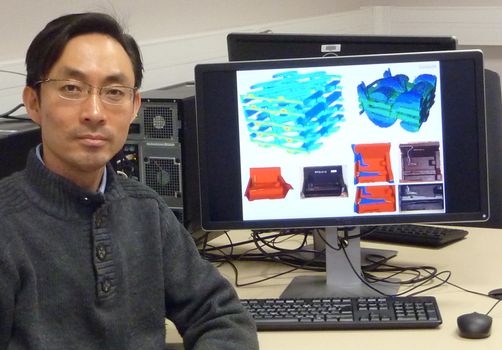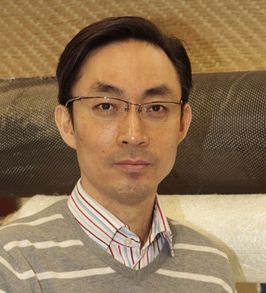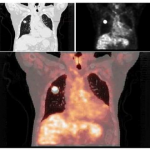Flax and hemp among tomorrow’s high-performance composite materials
Composite materials are increasingly being used in industry, especially in the transport sectors (automotive and aeronautics). These lightweight and multifunctional materials have great potential for limiting environmental footprint, and will play a major role in the materials of future. At Mines Douai, Chung-Hae Park is contributing to the development of high-performance and economically viable composites. A distinguishing feature of these materials is that they are made using plant-based resources: they are composed of at least 45% natural fibers (by volume), combined with polymer matrices which are also bio-based, and exhibit high mechanical performance while they can be rapidly manufactured.
In a restrictive environmental context (the European Union aims to lower greenhouse gas emissions by 80 to 95 % between now and 2050), it is absolutely necessary to reduce energy consumption, and that of fuel in particular. However, the improvements of automobile and aircraft engines seem to be reaching their limits. The other solution is to make vehicles and their components lighter by using composite materials. “This idea has been implemented for several decades and fiberglass and carbon fibers are increasingly being incorporated into polymer matrices“, explains Chung-Hae Park. “In civil and military aviation, composites already represent 50% of the total mass of certain models (Airbus 350 and Boeing 787 Dreamliner).”
However, there are still some problems: to begin with, the cost of these materials is much higher than that of metals (steel or aluminum), and it is no easy matter to recycle these heterogeneous materials since their components are extremely difficult to separate once assembled. This is where plant fibers come into play.
Getting flax and hemp to the same level as the conventional synthetic fibers
The Composites and Hybrid Structures group of the TPCIM (Polymers and Composites Technology & Mechanical Engineering) department at Mines Douai, led by Chung-Hae Park, is currently the only academic partner involved in two important but complementary national projects: FIABILIN and SINFONI, both of which were selected as part of the Future Investments Program.
These projects were launched in 2012 for five years, and are helping to structure the French industry producing plant fibers for use in engineering materials (insulation, reinforced plastics, agro-based composites), with final applications in a wide range of industries (automotive, aeronautics, railways, building, etc.) Besides being lightweight and agro-based (annually renewable resources), plant fibers offer the advantage of being degradable and therefore recyclable. “Unfortunately many of them aren’t yet strong enough compared with fiberglass and carbon fiber. In France, flax and hemp are the most promising,” comments Chung-Hae. “Our goal, through the FIABILIN and SINFONI projects, is to establish their position among the most widely-used fibers for composites, just behind fiberglass and carbon fibers.”
Researchers at the TPCIM department are contributing to these projects by studying the natural variability of plant fibers and the consequences of this variability on the properties for composite applications (molding characteristics, mechanical performance). This involves overcoming a great technological barrier for this type of material, and developing the necessary numerical simulation tools for virtual engineering which can be used for industrial product development while taking their specific features into account (fiber variability, as well as porosity or process –induced defects, for example) and including this information in models for simulating manufacturing process technology and performance prediction.
Additionally, the experts in polymer and composites processing at Mines Douai are developing novel molding processes by direct impregnation of reinforcements for manufacturing 100% agro-based and high performance parts, i.e. parts that have a volume ratio of at least 45% plant fibers. One of the biggest challenges is lowering the production cost of these parts by reducing the time required to manufacture one component in a chain (i.e. by increasing production speed) to a maximum of two minutes, as required by the automobile industry for example. “In this group we are interested in every step of a product’s life, from material characterization, part production, and its integration in a multi-material assembly with metals or elastomers, to its structural health monitoring during the service life and recycling at the end of life,” emphasizes Chung-Hae.
Smart processes and materials
 A complete understanding of the long-term behavior of these materials and their assemblies is crucial for the development of industrial applications, but these aspects are difficult to predict for these new materials with such a short history (unlike metals). In order to monitor how these industrial parts evolve over several decades (the operational life of a civil aircraft for example), nondestructive testing must be carried out over the service life, today. The Composites and Hybrid Structures group is working on the possibility of removing this expensive and tedious nondestructive testing by integrating in-situ sensors in the structure of the material itself, making it a smart composite which can be remotely monitored online.
A complete understanding of the long-term behavior of these materials and their assemblies is crucial for the development of industrial applications, but these aspects are difficult to predict for these new materials with such a short history (unlike metals). In order to monitor how these industrial parts evolve over several decades (the operational life of a civil aircraft for example), nondestructive testing must be carried out over the service life, today. The Composites and Hybrid Structures group is working on the possibility of removing this expensive and tedious nondestructive testing by integrating in-situ sensors in the structure of the material itself, making it a smart composite which can be remotely monitored online.
There are plans to take this idea a step further, integrating the same type of sensor into tools for manufacturing composite parts in order to test or even improve the product quality in real time. The goal is to head toward a digital chain integrating design/production/testing of composites and their assemblies in response to high industrial demand. “We are doing things differently with this research“, states Chung-Hae, “and even though there are many teams in France and Europe working on agro-based composites, we stand out for the range of performances we strive for, with a minimum of 45% of fibers in the form of textile reinforcements by a cost-effective manufacturing technology, i.e. direct impregnation technique, guaranteeing high mechanical properties, as well as for our level of expertise in numerical simulation of manufacturing processes for the industrial parts involved.”
Composite materials will undoubtedly remain one of the major areas of interest for research in the future. This subject is also included in the seven themes defined by the Industry of the Future Alliance, in which Institut Mines-Télécom participates and which strives to implement the governmental plan with the same name, launched in 2015.
 After earning his bachelor’s and master’s degrees from Seoul National University (South Korea), in 2000 Chung-Hae Park began working on a Ph.D. thesis on composite materials through a joint-supervision arrangement. For three years, he spent six months a year at Seoul National University and six months a year at Mines Saint-Étienne. This great challenge was exceptional in South Korea, where this type of thesis is extremely rare.
After earning his bachelor’s and master’s degrees from Seoul National University (South Korea), in 2000 Chung-Hae Park began working on a Ph.D. thesis on composite materials through a joint-supervision arrangement. For three years, he spent six months a year at Seoul National University and six months a year at Mines Saint-Étienne. This great challenge was exceptional in South Korea, where this type of thesis is extremely rare.
Chung-Hae received his PhD in 2003 then started working in Korea for the petrochemical branch of LG, in collaboration with many international companies, in the automotive industry in particular. He left LG to pursue his passion for teaching and passing on knowledge, obtaining an assistant professor/associate professor position at the Université du Havre in 2005. In 2011, Chung-Hae earned a Diplome of Habilitation (HDR), still in the field of composite materials. Drawn to Mines Douai’s breakthrough research in this field, he joined the team as a full professor two years later.
He has been the head of the Composites and Hybrid Structures group of the TPCIM (Polymers and Composites Technology & Mechanical Engineering) department since 2014. This group gathers together some 30 people (full professors/assistant & associate professors, technicians, research engineers, post-doctoral researchers; Ph.D. students).





Leave a Reply
Want to join the discussion?Feel free to contribute!